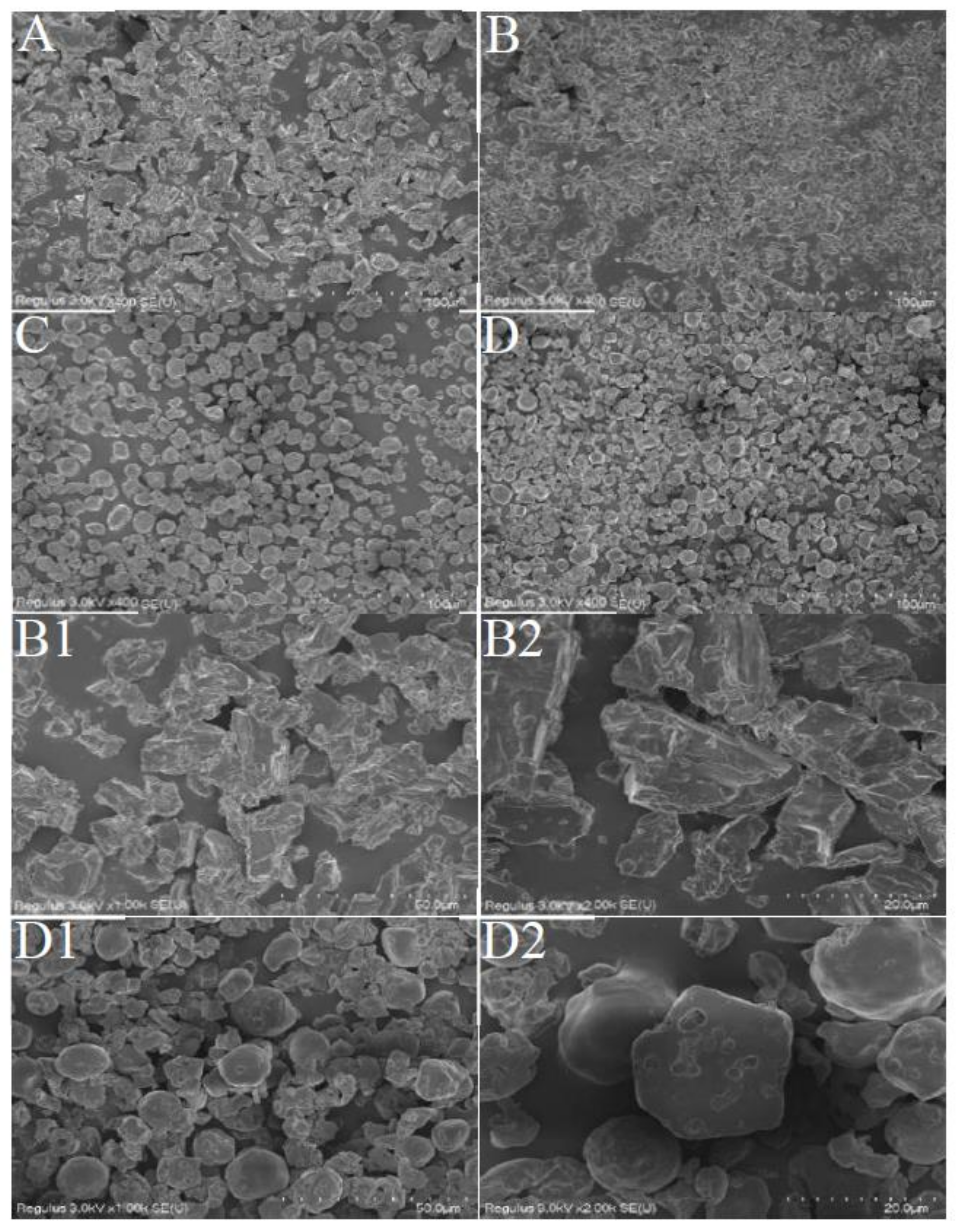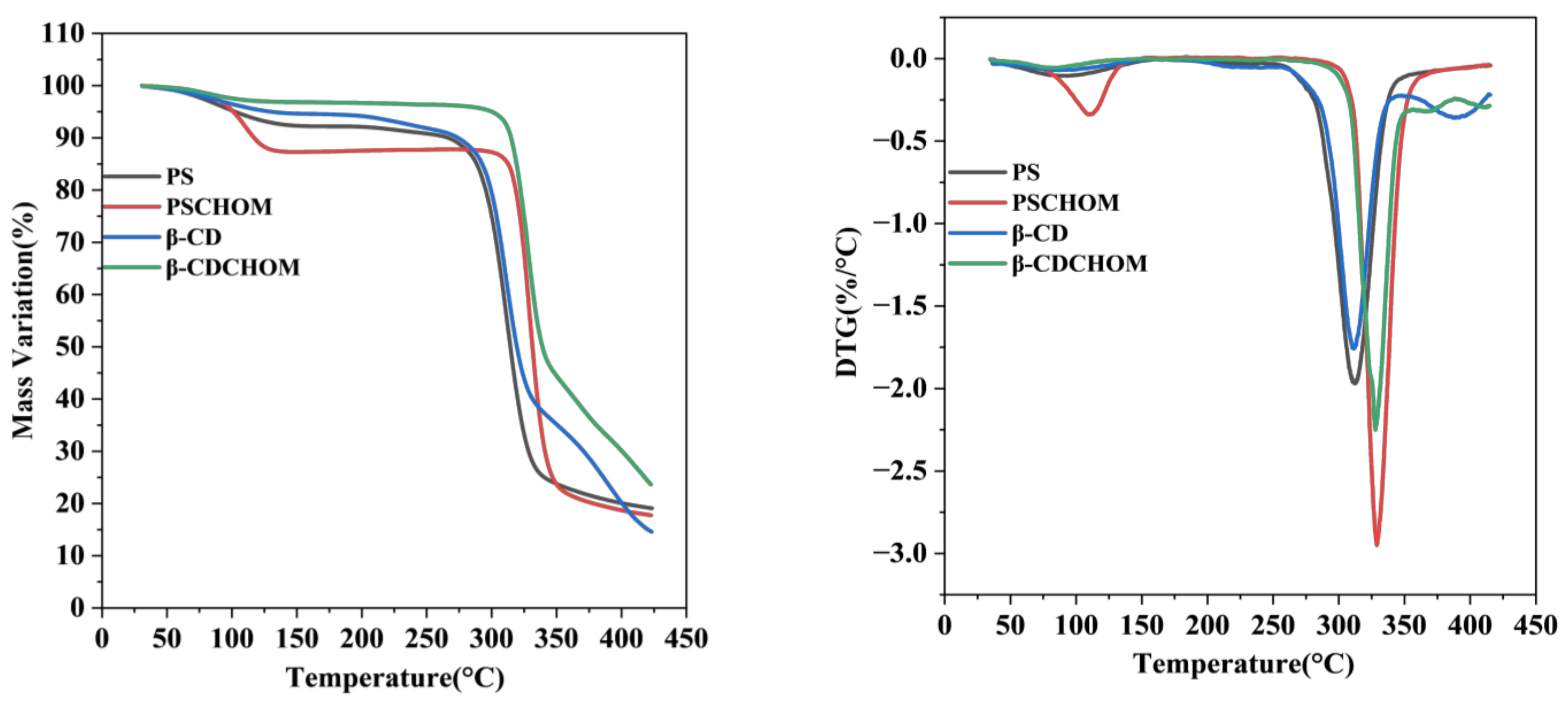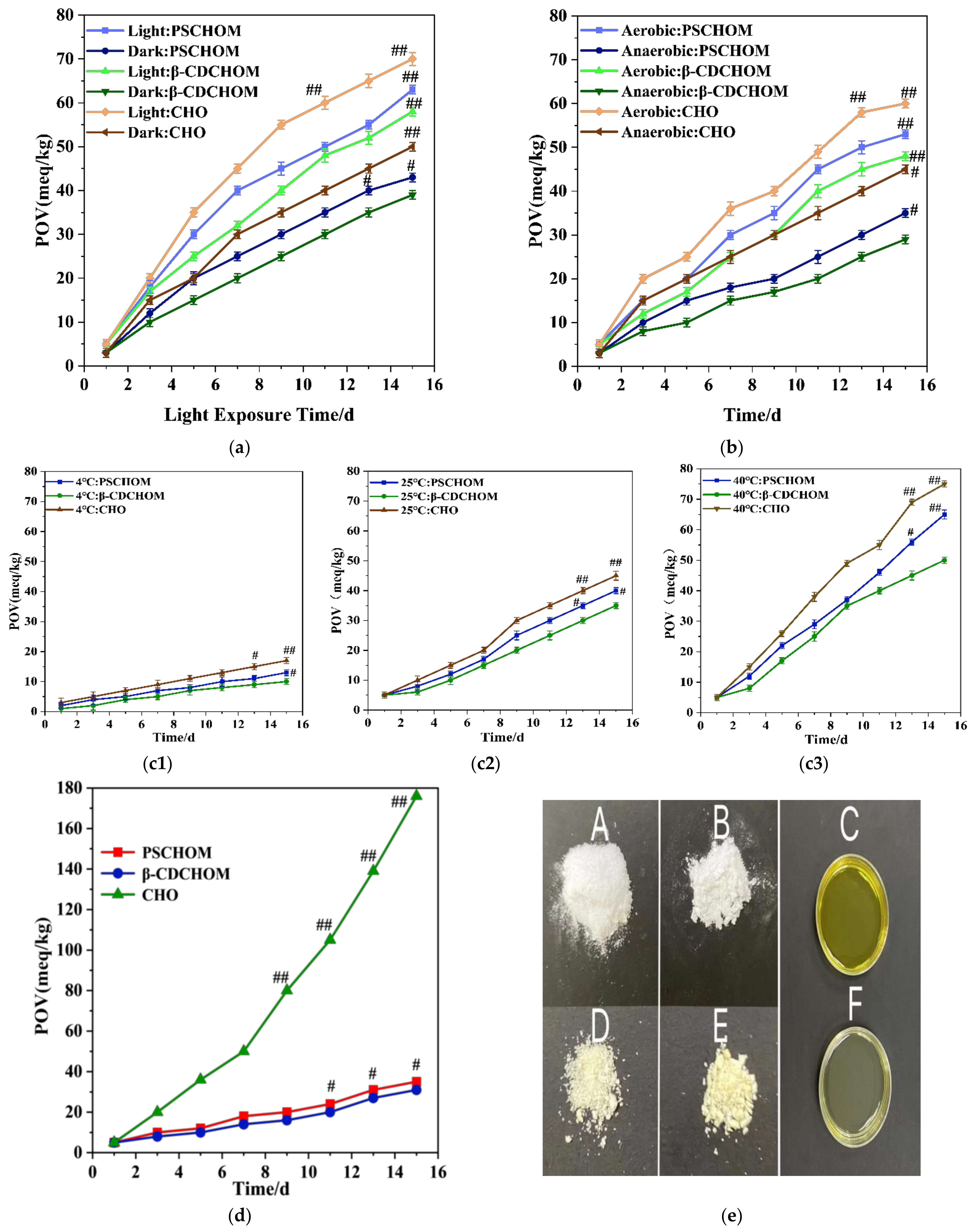Microencapsulation with Different Starch-Based Polymers for Improving Oxidative Stability of Cold-Pressed Hickory (Carya cathayensis Sarg.) Oil
Abstract
1. Introduction
2. Materials and Methods
2.1. Materials and Chemicals
2.2. Preparation of CHO
2.3. Preparation of CHOMs
2.4. EE Analysis
2.5. Characterization of CHOMs
2.5.1. Particle Size Distribution Analysis
2.5.2. SEM Analysis
2.5.3. FT-IR Spectroscopy
2.5.4. XRD Analysis
2.5.5. TG and DTG Analyses
2.6. Oxidation Stability
2.6.1. Effect of Light on POV of Microcapsules
2.6.2. Effect of Oxygen on POV of Microcapsules
2.6.3. Effect of Temperature on POV of Microcapsules
2.6.4. Effect of Storage Time on POV of Microcapsules
2.7. Statistical Analysis
3. Results and Discussion
3.1. Encapsulation Efficiency of Microcapsules
3.2. Characterization of CHOMs
3.2.1. Size Distribution of CHOMs
3.2.2. Microstructures of CHOMs
3.2.3. FT-IR Spectra
3.2.4. Thermogravimetric Analysis and Derivative Thermogravimetry Results
3.2.5. Oxidation Stability Results
4. Conclusions
Author Contributions
Funding
Data Availability Statement
Acknowledgments
Conflicts of Interest
Abbreviations
References
- Tauferova, A.; Dordevic, D.; Jancikova, S.; Tremlova, B.; Kulawik, P. Fortified cold-pressed oils: The effect on sensory quality and functional properties. Separations 2021, 8, 55. [Google Scholar] [CrossRef]
- Hu, L.; Du, M.; Zhang, J. Physicochemical properties and nutritional ingredients of kernel oil of Carya cathayensis Sarg. Am. J. Plant Sci. 2018, 12, 2494–2503. [Google Scholar] [CrossRef]
- Cai, Z.; Li, K.; Wan, J.L.; Reaney, M.T.J.; Zhang, N.; Wang, Y. Recent progress in the thermal treatment of oilseeds and oil oxidative stability: A review. Fundam. Res. 2021, 1, 767–784. [Google Scholar] [CrossRef]
- De Jesus Freitas, T.; Assunção, L.S.; de Lima Silva, V.; Oliveira, T.S.; Conceição, I.S.R.; Machado, B.A.S.; Nunes, I.L.; Otero, D.M.; Ribeiro, C.D.F. Prospective study on microencapsulation of oils and its application in foodstuffs. Recent Pat. Nanotechnol. 2022, 16, 219–234. [Google Scholar] [CrossRef] [PubMed]
- Tavares, L.; Santos, L.; Noreña, C.P.Z. Microencapsulation of organosulfur compounds from garlic oil using β-cyclodextrin and complex of soy protein isolate and chitosan as wall materials: A comparative study. Powder Technol. 2021, 390, 103–111. [Google Scholar] [CrossRef]
- Barbosa, J.; Borges, S.; Amorim, M.; Pereira, M.J.; Oliveira, A.; Pintado, M.E.; Teixeira, P. Comparison of spray drying, freeze drying and convective hot air drying for the production of a probiotic orange powder. J. Funct. Foods 2015, 17, 340–351. [Google Scholar] [CrossRef]
- Silva-Espinoza, M.A.; García-Martínez, E.; Martínez-Navarrete, N. Protective capacity of gum Arabic, maltodextrin, different starches, and fibers on the bioactive compounds and antioxidant activity of an orange puree (Citrus sinensis (L.) Osbeck) against freeze-drying and in vitro digestion. Food Chem. 2021, 357, 129724. [Google Scholar] [CrossRef]
- Carneiro, H.C.; Tonon, R.V.; Grosso, C.R.; Hubinger, M.D. Encapsulation efficiency and oxidative stability of flaxseed oil microencapsulated by spray drying using different combinations of wall materials. J. Food Eng. 2013, 115, 443–451. [Google Scholar] [CrossRef]
- Szejtli, J. Introduction and general overview of cyclodextrin chemistry. Chem. Rev. 1998, 98, 1743–1754. [Google Scholar] [CrossRef]
- Maes, C.; Bouquillon, S.; Fauconnier, M.L. Encapsulation of essential oils for the development of biosourced pesticides with controlled release: A review. Molecules 2019, 24, 2539. [Google Scholar] [CrossRef]
- Zhang, B.; Cui, D.; Liu, M.; Gong, H.; Huang, Y.; Han, F. Corn porous starch: Preparation, characterization and adsorption property. Int. J. Biol. Macromol. 2012, 50, 250–256. [Google Scholar] [CrossRef]
- Li, Q.; Lu, S.; Wang, Y.; Zheng, M.; Wang, L. Effect of cold pressing and aqueous enzymatic extraction methods on the active ingredients of Carya cathayensis oil. China Oils Fats 2022, 47, 23–27. [Google Scholar] [CrossRef]
- Hibbert, S.; Welham, K.; Zein, S.H. An innovative method of extraction of coffee oil using an advanced microwave system: In comparison with conventional Soxhlet extraction method. SN Appl. Sci. 2019, 1, 1467. [Google Scholar] [CrossRef]
- Peng, W.; Yan, X. Preparation of rung oil microcapsule and its effect on wood surface coating. Polymers 2022, 14, 1536. [Google Scholar] [CrossRef]
- Wang, Y.; Deng, H.; Huang, D.; Zeng, X. Improving the oxidation stability and shelf-life of peanut oil by addition of rosemary extract combined with vitamin C and ascorbyl palmitate. J. Food Qual. 2022, 2022, 7229412. [Google Scholar] [CrossRef]
- Kahraman, G.; Özdemir, K.S. Effects of black elderberry and spirulina extracts on the chemical stability of cold pressed flaxseed oil during accelerated storage. J. Food Meas. Charact. 2021, 15, 4838–4847. [Google Scholar] [CrossRef]
- Li, C.; Tang, Z.; Huang, M.; Tao, N.; Feng, B.; Huang, S. Antioxidant efficacy of extracts produced from pickled and dried mustard in rapeseed and peanut oils. J. Food Sci. 2012, 77, 394–400. [Google Scholar] [CrossRef]
- Wang, X.; Yuan, Y.; Yue, T. The application of starch-based ingredients in flavor encapsulation. Starch Stärke 2015, 67, 225–236. [Google Scholar] [CrossRef]
- Chen, Z.; Zong, L.; Chen, C.; Xie, J. Development and characterization of PVA-starch active films incorporated with β-cyclodextrin inclusion complex embedding lemongrass (Cymbopogon citratus) oil. Food Packag. Shelf Life 2020, 26, 100565. [Google Scholar] [CrossRef]
- Gary, R. The spray drying of food flavors. Dry. Technol. 2004, 22, 1289–1324. [Google Scholar] [CrossRef]
- Caciano, N.; Sara, B.; Elvira, C. Effects of xanthan gum additions on the viscoelasticity, structure and storage stability characteristics of prebiotic custard desserts. Food Biophys. 2015, 10, 116–128. [Google Scholar] [CrossRef]
- Karen, M.; Oluwafemi, C.; Albert, R.; Umezuruike, O. Physical and antifungal properties of β-cyclodextrin microcapsules and nanofibre films containing cinnamon and oregano essential oils. LWT Food Sci. Technol. 2018, 87, 413–422. [Google Scholar] [CrossRef]
- Zheng, X.; Qiu, C.; Long, J.; Jiao, A.; Xu, X.; Jin, Z.; Wang, J. Preparation and characterization of porous starch/β-cyclodextrin microsphere for loading curcumin: Equilibrium, kinetics and mechanism of adsorption. Food Biosci. 2021, 41, 101081. [Google Scholar] [CrossRef]
- Huang, C.; Wang, S.; Yang, H. Evaluation of thermal effects on the bioactivity of curcumin microencapsulated with porous starch-based wall material using spray drying. Processes 2020, 8, 172. [Google Scholar] [CrossRef]
- Rabia, G.; İbrahim, G. FT-IR spectroscopy based investigation of stability in wheat germ oil body emulsions as affected by general processing treatments. J. Food Meas. Charact. 2021, 15, 3026–3035. [Google Scholar] [CrossRef]
- Zhang, Y.; Zhang, F.; Kiran, T.; Ci, A.; Wang, H.; Zhang, J.G.; Wei, Z.J. Effect of natural polyphenol on the oxidative stability of pecan oil. Food Chem. Toxicol. 2018, 119, 489–495. [Google Scholar] [CrossRef]
- He, W.; Lin, Q. Efficient saponification and separation of unsaponifiables for authentication of sesame oil using FT-IR spectroscopy and chemometrics. Spectrosc. Spect. Anal. 2021, 41, 319–326. [Google Scholar] [CrossRef]
- Gagneten, M.; Buera, M.; Rodríguez, S. Evaluation of SIMCA and PLS algorithms to detect adulterants in canola oil by FT-IR. Int. J. Food Sci. Technol. 2020, 56, 2596–2603. [Google Scholar] [CrossRef]
- Claudia, B.; Barbara, G.; Maria, T.; Antonio, F.; Elena, V. Oxidative stability of high-oleic sunflower oil in a porous starch carrier. Food Chem. 2015, 166, 346–351. [Google Scholar] [CrossRef]
- Medeleanu, M.A.; Hădărugă, D.I.; Muntean, C.V.; Popescu, G.; Rada, M.; Hegheş, A.; Zippenfening, S.E.; Lucan, C.A.; Velciov, A.B.; Bandur, G.N.; et al. Structure-property relationships on recrystallized β-cyclodextrin solvates: A focus on X-ray diffractometry, FT-IR and thermal analyses. Carbohydr. Polym. 2021, 265, 118079. [Google Scholar] [CrossRef]
- Bordón, M.G.; Paredes, A.J.; Camacho, N.M.; Penci, M.C.; González, A.; Palma, S.D.; Ribotta, P.D.; Martinez, M.L. Formulation, spray-drying and physicochemical characterization of functional powders loaded with chia seed oil and prepared by complex coacervation. Powder Technol. 2021, 391, 479–493. [Google Scholar] [CrossRef]
- Başyiğit, B.; Yücetepe, M.; Karaaslan, A.; Karaaslan, M. High efficiency microencapsulation of extra virgin olive oil (EVOO) with novel carrier agents: Fruit proteins. Mater. Today Commun. 2021, 28, 102618. [Google Scholar] [CrossRef]
- Yang, X.; Gao, N.; Hu, L.; Li, J.; Sun, Y. Development and evaluation of novel microcapsules containing poppy-seed oil using complex coacervation. J. Food Eng. 2015, 161, 87–93. [Google Scholar] [CrossRef]
- Kaczmarska, K.; Żymankowska, S.; Grabowska, B.; Bobrowski, A.; Cukrowicz, S. Study of thermal degradation of starch-based binder by TG-DTG-DSC, Py-GC/MS and DRIFTS. Arch. Foundry Eng. 2019, 19, 21–26. [Google Scholar] [CrossRef]
- Lei, M.; Jiang, F.; Cai, J.; Hu, S.; Zhou, R.; Liu, G.; Wang, Y.; Wang, H.; He, J.; Xiong, X. Facile microencapsulation of olive oil in porous starch granules: Fabrication, characterization, and oxidative stability. Int. J. Biol. Macromol. 2018, 111, 755–761. [Google Scholar] [CrossRef]
- Liu, Z.; Li, Y.; Geng, S.; Mo, H.; Liu, B. Fabrication of food-grade Pickering high internal phase emulsions stabilized by the mixture of β-cyclodextrin and sugar beet pectin. Int. J. Biol. Macromol. 2021, 182, 252–263. [Google Scholar] [CrossRef]
- Isadiartuti, D.; Rosita, N.; Ekowati, J.; Syahrani, A.; Ariyani, T.; Rifqi, M.A. The thermodynamic study of p-methoxycinnamic acid inclusion complex formation, using β-cyclodextrin and hydroxypropyl-β-cyclodextrin. J. Basic Clin. Physiol. Pharmacol. 2021, 32, 663–667. [Google Scholar] [CrossRef]
- Zahran, H.; Bat, H.; Şahin, N. Influence of wall material combination on the lipid oxidation of the hazelnut oil microcapsules. Discov. Food 2022, 2, 17. [Google Scholar] [CrossRef]




| Starch-Based Polymers | Total Solids Contents in CHOMs (%) | EE (%) |
|---|---|---|
| MD | 29.02 ± 0.01 c | 39.36 ± 0.06 c |
| HP-β-CD | 30.13 ± 0.02 c | 48.32 ± 0.09 c |
| β-CD | 37.62 ± 0.01 a | 80.40 ± 1.02 a |
| PS | 34.87 ± 0.01 b | 75.52 ± 2.17 b |
| Microcapsules | D10 (µm) | D50 (µm) | D90 (µm) | Span (µm) |
|---|---|---|---|---|
| β-CDCHOM | 4.268 | 9.147 | 17.335 | 1.429 |
| PSCHOM | 4.979 | 9.380 | 16.425 | 1.220 |
Disclaimer/Publisher’s Note: The statements, opinions and data contained in all publications are solely those of the individual author(s) and contributor(s) and not of MDPI and/or the editor(s). MDPI and/or the editor(s) disclaim responsibility for any injury to people or property resulting from any ideas, methods, instructions or products referred to in the content. |
© 2023 by the authors. Licensee MDPI, Basel, Switzerland. This article is an open access article distributed under the terms and conditions of the Creative Commons Attribution (CC BY) license (https://creativecommons.org/licenses/by/4.0/).
Share and Cite
Li, Q.; Wang, L.; Zheng, M.; Lu, H.; Liu, Y.; Wang, Y.; Lu, S. Microencapsulation with Different Starch-Based Polymers for Improving Oxidative Stability of Cold-Pressed Hickory (Carya cathayensis Sarg.) Oil. Foods 2023, 12, 953. https://doi.org/10.3390/foods12050953
Li Q, Wang L, Zheng M, Lu H, Liu Y, Wang Y, Lu S. Microencapsulation with Different Starch-Based Polymers for Improving Oxidative Stability of Cold-Pressed Hickory (Carya cathayensis Sarg.) Oil. Foods. 2023; 12(5):953. https://doi.org/10.3390/foods12050953
Chicago/Turabian StyleLi, Qing, Lu Wang, Meiyu Zheng, Hanyu Lu, Yinying Liu, Yangguang Wang, and Shengmin Lu. 2023. "Microencapsulation with Different Starch-Based Polymers for Improving Oxidative Stability of Cold-Pressed Hickory (Carya cathayensis Sarg.) Oil" Foods 12, no. 5: 953. https://doi.org/10.3390/foods12050953
APA StyleLi, Q., Wang, L., Zheng, M., Lu, H., Liu, Y., Wang, Y., & Lu, S. (2023). Microencapsulation with Different Starch-Based Polymers for Improving Oxidative Stability of Cold-Pressed Hickory (Carya cathayensis Sarg.) Oil. Foods, 12(5), 953. https://doi.org/10.3390/foods12050953





